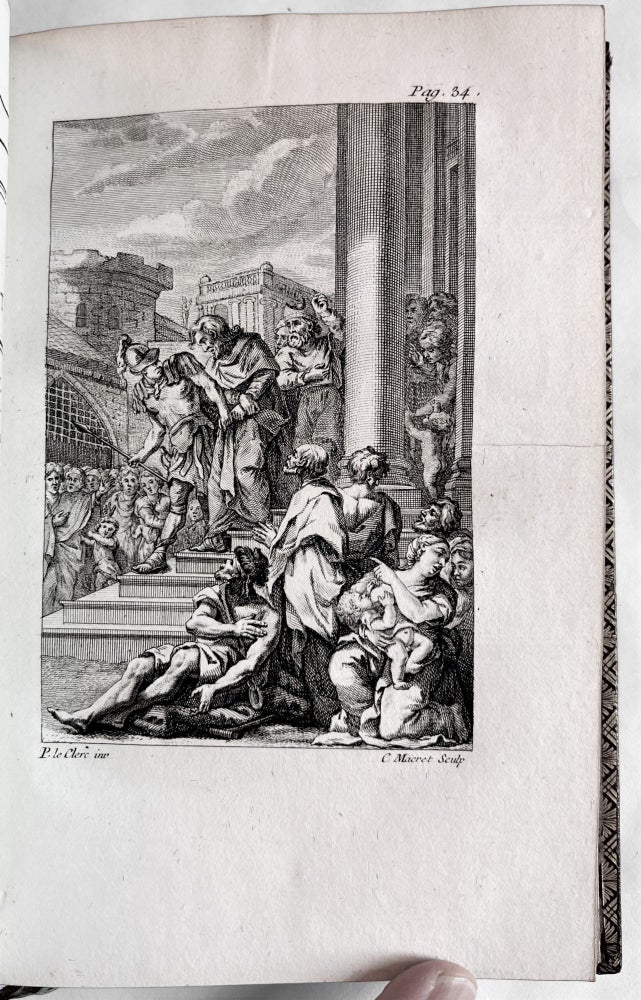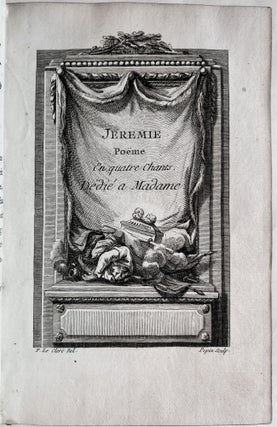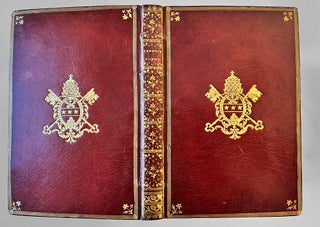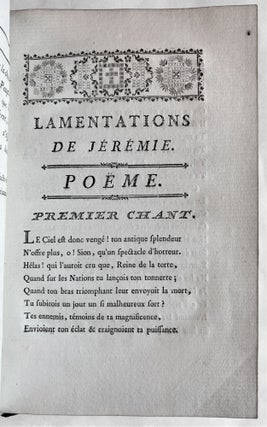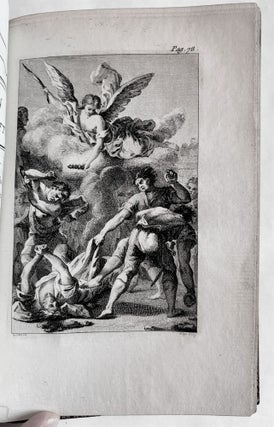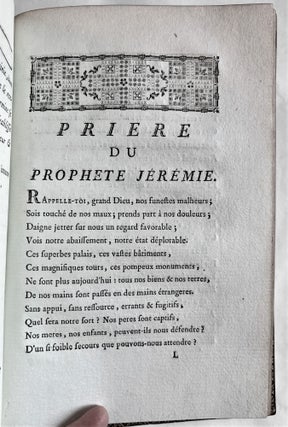Jérémie, Poëme en quatre chants. Avec sa priere, et sa lettre aux captifs, prêts a partir pour Babylone; dedié à Madame. Paris: G. Desprez, 1771.
8vo (200 x 130 mm). 126, [2] pp. Additional engraved title, 6 etched and engraved plates after Pierre Thomas Le Clerc by various engravers; woodcut headpiece by Caron, woodcut tailpieces, six different type-ornament headpieces. Printed on thick laid paper. Contemporary gold-tooled red morocco, covers with gold-blocked arms of Pope Clement XIX, fleurons at corners, smooth spine panelled with fleurons, stars, and other small tools, gilt edges (joints and extremities rubbed). Provenance: early price note on title; Pope Clement XIV (1705-1774), supra-libros; Jayne Wrightsman (1919-2019), bookplate.***
first edition of a poem using Jeremiah’s Lamentations and the Babylonian assault on Jerusalem as an allegory for a bien-pensant defence of the Church against the philosophes and their leader Voltaire.
“The figure of Jérémie was so deeply embedded in French culture that in the vitriolic debates of the eighteenth-century French Enlightenment, opposing sides could equally claim him as their own” (Callaway, p. 39). Using the trope of Jeremiah’s tears, Voltaire had skewered Arnaud’s 1752 Lamentations de Jérémie, odes sacrées, in a famous epigram, later “reheated” to make fun of Le Franc de Pompignan’s Poésies Sacrées. While Desmarais was thus not the only 18th-century defender of the “True Religion” to embrace the Jeremiah allegory, he was evidently more successful than his predecessors. His five chants and poetic interpretation of the Epistle of Jeremiah “interweave the story of Jérémie, the Passion of Christ, and the troubles of contemporary French Catholics. Desmarais’ Jérémie embodies the Baroque asthetic of intense emotion extravagantly expressed... [and] encodes the painful experiences of French Catholics smarting under the intellectual critiques of the philosophes and the undermining of their political power in the ruling Parlement.” (ibid., p. 42). The Vulgate text of the Book of Lamentations and of the Epistle of Jeremiah are printed at the end.
The five chants and the Epistle poem are each illustrated with an engraving after P. T. Leclerc, explained on the facing versos. “Three of the six illustrations [for chants 2, 3, and 5] particularly embody Desmarais’ fusion of Jérémie’s, Christ, and the attack on True Religion in a single narrative” (loc. cit.). The illustration for chant 2, depicting the high priest striking Jeremiah, who looks suspiciously like Jesus, shows a woman nursing a baby and in the background a crowd in front of a building that contemporaries would have immediately recognized as the Bastille.
The author, an erudite Trinitarian, doctor of the Sorbonne, was named in 1770 prior and curé of the village of Regniowez (Regnauvé on the title), in the Ardennes. He founded a school in his village for local children, many of whom could attend gratis. A legend that he was one of the many illegitimate children of Louis XV appears to be apocryphal.
In a note to the reader the printer Desprez states that the original (unnamed) engraver was taken ill, hence several other engravers had to fill in on short notice (Pepin, Saillier, C. Macret, R. Delvaux, and S. C, Miger). His boast of the beauty of the typography is not unmerited, if only for the six delightful typographic bandeaux.
The preliminary matter of the second edition, printed in Ypres in 1772, includes a transcription of the author’s letter to Pope Clement XIV, presenting him with a copy of the book, and the Pope’s response. This copy with the Pope’s arms may be that same copy (no copy is listed in the Vatican Library’s online catalogue).
The dedicatee, “Madame,” was then seven-year old Élisabeth of France, sister of the Dauphin and soon to be Louis XVI. The Morgan Library holds a copy with her arms, presumably the dedication copy, also later owned by the noted collector and philanthropist Jayne Wrightsman (most but not all of whose books were left to the Morgan). OCLC locates 2 other US institutional copies (UCLA and Harvard).
Cohen-de Ricci 298; Thieme-Becker 22: 523; Michaud, Biographie Universelle (1854), vol. 41:672 (”ce poëme qui respire une certaine verve poétique ...”); M. Callaway, Jeremiah through the Centuries (Hoboken 2020), pp. 39-42 & passim. Item #4229
Price: $3,500.00

